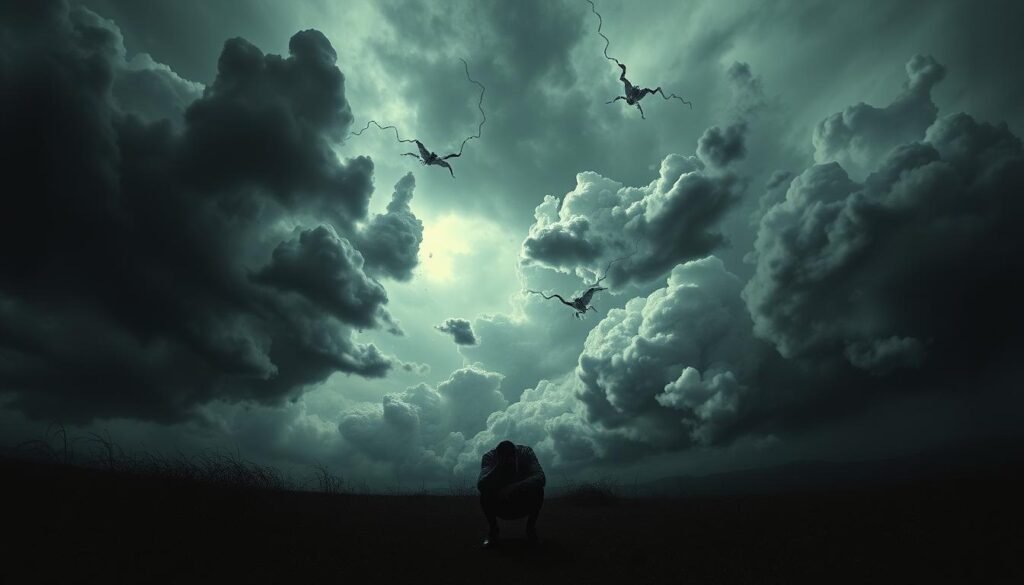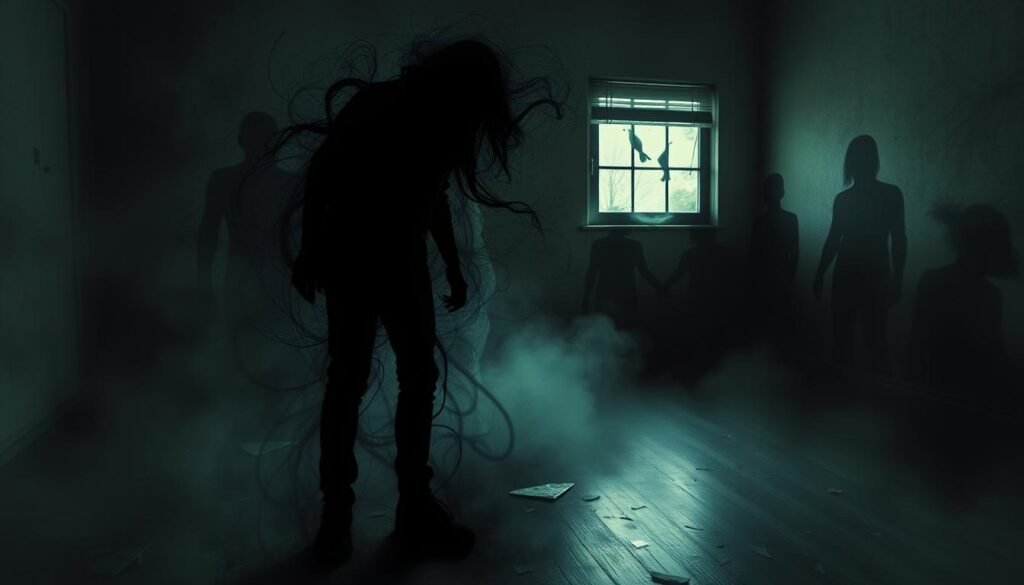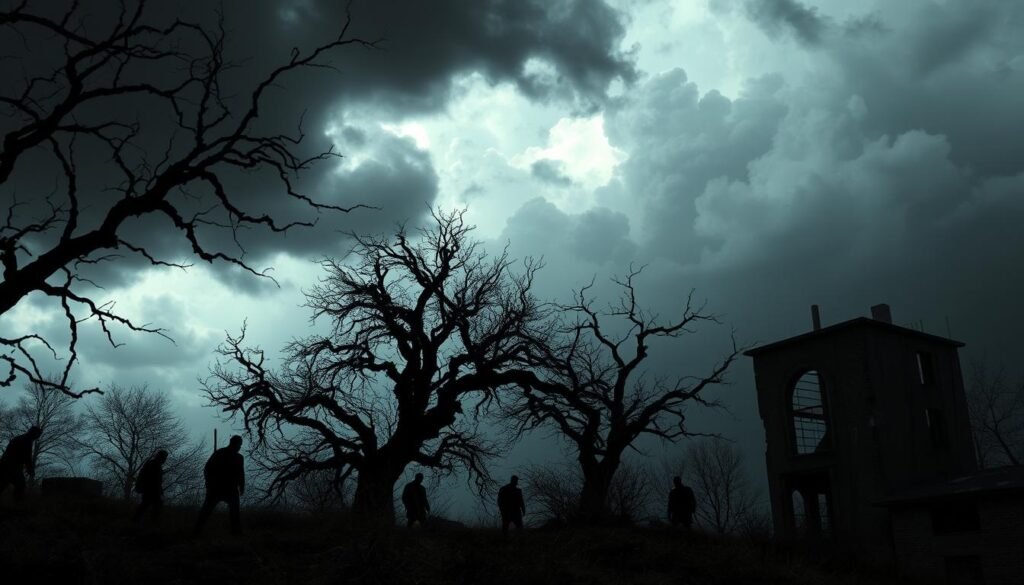Between 10 to 19 percent of those with major depression might see or hear things that are not there. This fact sheds light on how complex depression can be, especially when it leads to psychosis. Few know that depression can turn into depressive psychosis, bringing hallucinations.
This piece explores the link between severe depression and hallucinations. It dives into why depression might cause such symptoms. The goal is to understand the symptoms, how to diagnose them, and what treatment looks like for those affected by this aspect of mental health.
For more info on this topic, go see WebMD’s comprehensive guide on psychotic depression.
Key Takeaways
- 10-19% of people with major depression may experience psychosis.
- Rates of MDD with psychosis among hospitalized patients can reach 45%.
- Diagnosis of MDD with psychotic features can sometimes be missed.
- Older adults are particularly vulnerable to psychotic symptoms related to depression.
- Effective treatments include medications and Electroconvulsive Therapy (ECT).
Understanding Depression and Its Symptoms
Depression is a serious mental health problem. It greatly affects everyday life. People with depression face a range of depression symptoms. These include feeling sad all the time, losing interest in fun activities, and feeling very tired. They may also find it hard to think clearly or make choices, making daily tasks difficult.
Major depressive disorder is a type of depression you can get at any age, though it’s more common in young adults. Severe depression symptoms can show up as physical problems, like headaches or stomach issues. This makes it hard to figure out what’s wrong. Sleep problems, like sleeping too little or too much, can make people feel even worse.
Severe depression does more than make you feel sad; it can harm your life and health. It traps people in a cycle of negative thoughts. Spotting these signs early is crucial. The sooner you get help, the better the chances of getting better.
| Common Depression Symptoms | Duration and Effect |
|---|---|
| Persistent sadness | Lasts most of the day, nearly every day |
| Loss of interest in activities | Significantly decreases enjoyment |
| Fatigue | Can lead to reduced energy for daily tasks |
| Changes in sleep patterns | May contribute to emotional instability |
| Cognitive difficulties | Affects decision-making and concentration |
What Are Hallucinations?
Hallucinations are when you sense things that aren’t there. They can be sounds, sights, smells, touches, or tastes. It’s key to know the different kinds to spot mental health issues.
Some people might hear voices no one else does, see things that aren’t there, or feel things on their skin. These can show us a lot about someone’s mental health. Like, if someone with severe depression starts having these experiences, it’s a sign they might also be dealing with psychosis.
Understanding hallucinations helps us diagnose and treat mental health problems better. They often point to bigger challenges. So, treating both the hallucinations and what causes them is important.
Can Depression Cause Hallucinations
Looking into how severe depression and hallucinations connect is vital. It shows a big issue in mental health. Severe depression can lead to hallucinations. Doctors call it psychotic depression. This problem has usual depression symptoms plus scary hallucinations.
Link Between Depression and Psychosis
Psychotic depression mixes feelings of deep sadness with seeing or hearing things that aren’t there. Those with this condition may feel extremely guilty or not good enough. Studies show that more severe depression might increase the chance of hallucinations.
Types of Hallucinations Experienced
Hallucinations with psychotic depression usually are hearing or seeing things. What people experience includes:
- Audiory hallucinations depression: They may hear voices that make them feel worse about themselves.
- Visual hallucinations depression: Some see things that aren’t real, making their fears worse.
It’s important to understand these hallucinations to help people. Getting help early can make a big difference for those dealing with these issues.
Psychotic Depression: An Overview
Psychotic depression is a complex kind of major depressive disorder with psychotic symptoms. It’s vital to grasp this condition because it impacts a modest, but important, fraction of those with depression. In the U.S., around 22.5 million individuals yearly report a major depressive episode. However, less than one percent have been diagnosed with psychotic depression over their life or in the past year.
It’s crucial to distinguish between psychotic depression and depressive psychosis for right diagnosis and care. People with severe depression can become psychotic when hospitalized. This makes their treatment more difficult. Studies show that 14.7% to 18.5% of patients with severe depression may also have psychotic symptoms. Genetics, stress, and certain personality traits frequently play a role in this disorder.
Psychotic depression can bring about many severe symptoms. It’s key to look for help early. Treatments can vary but may include therapy and medicines. Cognitive behavioral therapy is one evidence-based treatment. It helps patients by tackling their negative thoughts.

Symptoms of Psychotic Depression
It’s vital to know the symptoms of psychotic depression for early help. This condition shows both severe depression and psychotic signs. Spotting these symptoms is the first step to getting better.
Common Symptoms
People with this illness face many challenges in their daily lives. These include:
- Persistent feelings of sadness or emptiness
- Loss of interest or pleasure in activities
- Emotional dysregulation, leading to unpredictable mood swings
- Agitation or irritability
- Feelings of hopelessness and worthlessness
They might also deal with hallucinations or delusions. This can make it hard to connect with others. It’s tough for them to share how they feel.
Severe Depression Symptoms
Some people may have even worse symptoms. These can greatly affect their life. They may struggle with:
- Extreme fatigue and lack of energy
- Significant changes in appetite and weight
- Inability to concentrate or make decisions
- Withdrawal from social interactions and activities
- Thoughts of self-harm or suicidal ideation
About 14.7 to 18.5 percent of people with major depression have psychotic features. Knowing and tackling these tough symptoms is key. It makes a big difference in recovery. For more on psychotic depression, read this medical overview.
| Symptom | Description |
|---|---|
| Emotional Dysregulation | Difficulty managing emotions, leading to significant mood swings. |
| Agitation | Increased restlessness and irritability, causing distress and discomfort. |
| Psychotic Features | Includes hallucinations and delusions, affecting perception of reality. |
| Isolation | Avoidance of social situations, increasing feelings of loneliness. |
Diagnosis of Depression with Psychotic Features
Diagnosing depression with psychotic features is hard for healthcare workers. Psychotic depression is rare, affecting about 4 in 1,000 people. It’s more common in those over 60, impacting 14 to 30 per 1,000.
Identifying it correctly needs detailed checks. Doctors use exams, questionnaires, and sometimes brain scans. These help rule out other health issues. A mistake in diagnosing can cause wrong treatment plans. In fact, a study by NIMH showed 27% of patients were initially misdiagnosed.
People with MDD may not fully share their psychotic symptoms. This makes diagnosis tough. Often, data underestimates how common this issue is. It’s thought to be present in 10-19% of those with major depression. This rate goes up with age.
Doctors need to be very careful in their evaluations. Being thorough is key to getting patients the help they need quickly. Carelessness can lead to bad treatment paths. Helpful insights are found in new studies and writings. They stress the need for accurate, kind evaluations.

Treatment Options for Psychotic Depression
Treating psychotic depression needs a mix of drugs and alternate approaches. It’s important to understand what the patient is going through. This helps in choosing the right treatment options.
Medications Used in Treatment
Certain medicines are key for managing psychotic depression. They help balance mood and control symptoms. The American Psychiatric Association recommends using an antidepressant with an antipsychotic. However, only a small number of patients get this combo.
Studies show combining sertraline with olanzapine improves outcomes. Around half of the patients see recovery in two to three months. Most get better within six to twelve months.
| Medication Combination | Efficacy |
|---|---|
| Sertraline + Olanzapine | More effective than Olanzapine monotherapy |
| Fluoxetine + Olanzapine | Greater reduction in depression scores |
| Venlafaxine + Quetiapine | More effective than Venlafaxine alone |
Electroconvulsive Therapy (ECT)
ECT is an option when meds don’t work. It’s particularly good for severe cases. It’s crucial to monitor patients closely during ECT.
Adding antidepressants to ECT can improve results. It ensures patients get well-rounded care.
Risk Factors for Developing Psychotic Depression
Psychotic depression has several risk factors. Knowing them helps with prevention and early help. Genetics play a big role, as do environmental triggers. These can make a person more likely to get this disorder. Figuring out these triggers helps us understand the disorder better.
Genetic and Environmental Factors
Genes are a big part of psychotic depression. If your family has a history of mental illness, your risk is higher. This is especially true if psychosis is in your family history. The stats show that family background matters a lot:
| Risk Factor | Association Strength (Adjusted Odds Ratio) |
|---|---|
| Family history of mental illness | 10.68 |
| Family history of psychosis | 12.85 | Childhood adversity | 2.57 |
| Living alone | 2.26 |
Things like not having a job or feeling lonely raise the risk too. Not having a job is linked with an odds ratio of 2.12. Not having close friends is even worse, with a ratio of 4.71. Being socially isolated really affects your mental health. These external factors create stress that can lead to psychotic depression.
Situational Triggers
Life stressors are situational triggers for psychotic depression. Big changes, trauma, or constant stress can trigger it. Research finds that seeing friends less than once a month raises the risk. This rate is at 4.24. Knowing this helps in finding and helping people earlier, which can improve mental health outcomes.

Long-Term Outlook and Recovery
Many people can recover from psychotic depression. They need the right mix of treatments to get better. These include medication, therapy, and strong support networks.
The impacts of not treating depression early can be big. People with psychotic depression need close watch to prevent a relapse. Having depression and schizophrenia makes some risks higher. These include safety issues and substance abuse. Support from health experts, friends, and family is key to recovery.
It’s important to understand this type of depression well. This helps in creating the best treatment plans. Ongoing therapy and access to mental health resources like support groups help manage symptoms.
Research tells us to keep looking ahead. Staying active, getting regular check-ups, and sticking with treatment plans can really help. The National Institute of Mental Health has great info on how to improve recovery chances.
| Factor | Impact on Recovery |
|---|---|
| Medication Management | Essential for symptom control and preventing relapses |
| Therapeutic Interventions | Supports emotional processing and coping strategies |
| Social Support | Promotes resilience and eases feelings of isolation |
| Regular Monitoring | Helps recognize early warning signs of relapse |
| Engagement in Activities | Encourages positive mental health and social interactions |
Recovery from psychotic depression is hard, but there is hope. With the right help, anyone can overcome the challenges of their condition. They can achieve a stable and healthy life.
Conclusion
The link between severe depression and seeing or hearing things that aren’t there is complex. This insight into depression and hallucinations shows the struggles of those with psychotic features. Knowing that these symptoms can come from major depressive disorder (MDD) is key for quick help. This knowledge can make it easier to seek help, reducing stigma.
Talking about mental health helps us notice signs of psychotic depression. It’s important for everyone to know the risks, signs, and impacts of this condition. Knowing more about the link between mood disorders and psychosis can lead to quicker diagnosis and treatment.
To address these mental health challenges, we must keep researching and educating. More awareness leads to better support and help for those suffering. This support can greatly improve their lives and recovery.